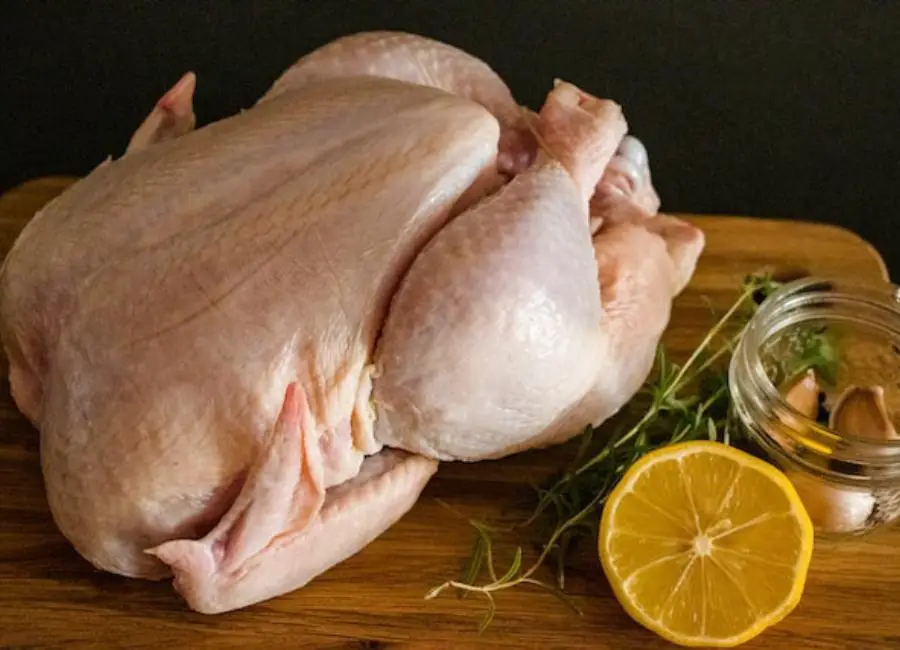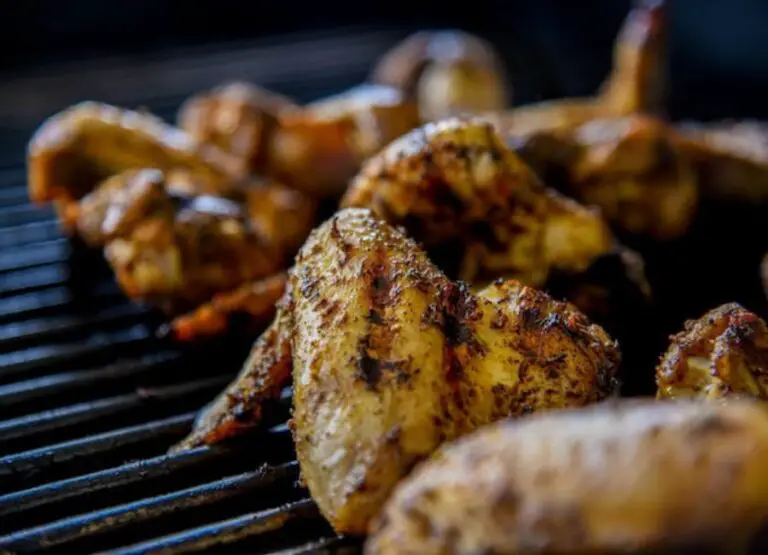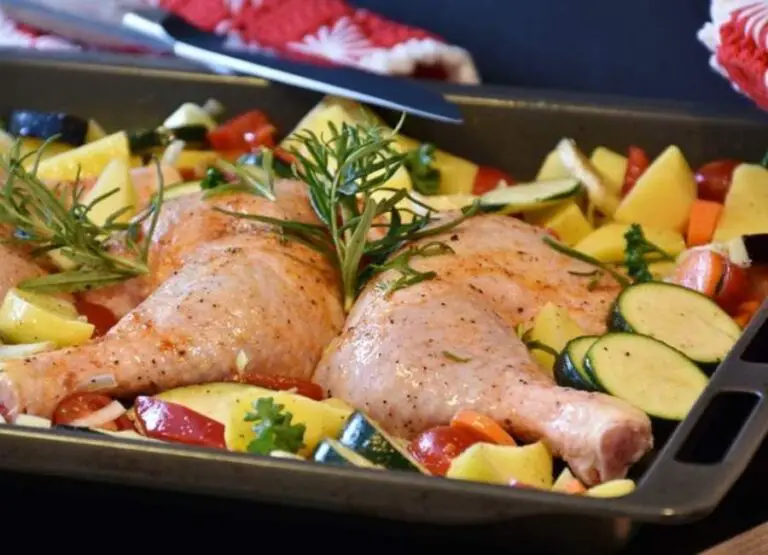How To Prevent Salmonella In Chicken [11 Hints]
Hey there foodies! If you’re anything like us, chicken is probably a staple in your diet.
However, did you know that chicken is a common carrier of salmonella, bacteria that can cause serious food poisoning if not handled properly?
Don’t worry, though, we’ve got you covered! In this quick read, we’ll share some easy tips on preventing salmonella in your chicken and keeping you and your loved ones safe and healthy.
So let’s dive in!
What is Salmonella in chicken?
Salmonella is a type of bacteria that can cause illness in humans. It is commonly found in raw or undercooked poultry, especially chicken, as well as in eggs and other foods.
People eating food contaminated with Salmonella can develop symptoms such as diarrhea, fever, and abdominal cramps.
It’s important to handle and cook chicken properly to reduce the risk of Salmonella infection.
Common sources of Salmonella contamination in chicken
Salmonella is a bacterium that can cause foodborne illness, with chicken being a common source of contamination.
Here are some common sources of Salmonella contamination in chicken:
- Feces: The most common source of Salmonella contamination in chickens is feces. When chickens are raised in overcrowded and unsanitary conditions, the risk of fecal contamination increases.
- Cross-contamination: Cross-contamination is another common source of Salmonella contamination. If chicken is not handled and cooked properly, it can contaminate other foods and surfaces in the kitchen.
- Contaminated feed: Chickens can become contaminated with Salmonella through their feed. If the feed they consume is contaminated, the bacteria can pass through the chicken and end up in their meat and eggs.
- Poorly cooked chicken: If chicken is not cooked to the appropriate temperature, it can harbor Salmonella bacteria. Therefore, it is important to cook the chicken to an internal temperature of 165 °F to kill any bacteria that may be present.
- Improper storage: If chicken is not stored at the proper temperature, bacteria can grow and multiply, increasing the risk of Salmonella contamination. It is important to store chicken in the refrigerator or freezer at a temperature of 40°F or below to prevent bacterial growth.
How To Prevent Salmonella In Chicken
To prevent salmonella in chickens, it is important to follow certain food safety practices.
One should always cook the chicken to a safe temperature of 165 °F to kill any harmful bacteria, including salmonella.
It is also important to prevent cross-contamination by using separate cutting boards and utensils for raw chicken and other foods.
Additionally, washing hands and surfaces regularly can help prevent the spread of salmonella.
Ways to prevent Salmonella in chicken
Here are some common ways to prevent Salmonella in chicken:
1. Buy Chicken from Reliable Sources
It is critical to find trustworthy and trusted suppliers when purchasing chicken.
Look for suppliers who prioritize food safety and follow stringent quality control requirements.
Ensure the chicken you buy is fresh, properly wrapped, and exhibited at the proper temperature.
Avoid purchasing chicken from establishments or sellers whose sanitary or handling standards raise concerns.
2. Practice Safe Food Handling
To avoid Salmonella transmission, it is critical to maintain good hygiene throughout the handling procedure.
Begin by properly washing your hands with warm water and soap for at least 20 seconds before and after handling raw chicken.
This simple yet efficient practice aids with the removal of microorganisms from your hands.
To avoid cross-contamination, use separate cutting boards, utensils, and plates for raw and cooked items. After each usage, clean and sterilize these things.
3. Store Chicken Properly
It is critical to preserve chicken at the proper temperature to prevent the formation of bacteria, including Salmonella.
Refrigerate raw chicken in sealed containers or plastic bags on the lowest shelf, away from other items.
This keeps any leakage or leaking from contaminating other goods in the refrigerator.
The recommended temperature for storing raw chicken is below 40 °F (4 °C).
Allowing the chicken to sit at room temperature for extended periods of time encourages bacterial growth.
4. Avoid Cross-Contamination
To keep Salmonella at bay, it is critical to avoid cross-contamination. Clean and sanitize any surfaces, utensils, and kitchen equipment that come into touch with raw chicken.
This includes counters, cutting boards, knives, tongs, and any other instruments used during preparation.
Avoid using the same utensils or cutting boards for raw chicken and other items such as vegetables or cooked food.
After handling raw chicken, properly wash your hands with soap and water to prevent bacteria from spreading to other surfaces.
Learn more about handling wood cutting boards after cutting raw chicken.
5. Cook Chicken Thoroughly
Proper cooking is essential for removing Salmonella bacteria from poultry.
Using a food thermometer, ensure that the chicken achieves a safe internal temperature of 165°F (74°C).
Insert the thermometer into the thickest portion of the meat, away from any bones.
Cooking chicken thoroughly destroys any potentially harmful bacteria, rendering it safe to eat.
Avoid eating pink or blood-tinged chicken since it implies undercooking.
6. Thaw Chicken Safely
Thawing chicken correctly is critical for preventing Salmonella growth. Avoid thawing chicken at room temperature because it encourages bacteria to proliferate quickly.
Instead, thaw it securely in the refrigerator or in your microwave using the defrost option.
Thawing in the refrigerator ensures that the temperature remains stable and controlled throughout, reducing the danger of Salmonella contamination.
7. Avoid Consuming Raw or Undercooked Chicken
Consuming raw or undercooked chicken raises the risk of Salmonella exposure significantly.
Avoid dishes that contain raw or partially cooked chicken, such as tartare or rare chicken.
Choose thoroughly cooked chicken to eliminate any harmful pathogens.
Be cautious when dining out and make sure the chicken dishes you order are cooked to the recommended safe internal temperature.
Learn more about eating undercooked chicken.
8. Practice Personal Hygiene
Personal cleanliness is essential for avoiding Salmonella infection. Encourage family members and kitchen staff to adopt good hygiene.
This includes washing hands with soap and warm water on a frequent basis, especially after using the restroom, contacting pets, or engaging in any activity that may contaminate hands.
To prevent the spread of bacteria, avoid touching your face or other surfaces while handling raw chicken.
Learn more about handling inflated raw chicken packages.
9. Educate Yourself on Food Safety
Keep up to date on food safety guidelines and advice from credible sources.
Learn correct handling, cooking, and storage practices for chicken and other food items.
This information will enable you to make educated decisions and protect yourself and your loved ones against Salmonella contamination.
Keep up to date on any new information or recalls about chicken or poultry products.
10. Be Mindful of Leftovers
It is critical to handle and store leftovers properly in order to prevent bacterial growth, including Salmonella.
Refrigerate leftover chicken immediately after cooking and consume it within three to four days.
When reheating the chicken, make sure it achieves an internal temperature of 165°F (74°C) to eliminate any remaining bacteria.
Remove any leftovers that have been at room temperature for more than two hours.
11. Be Cautious while Dining Out
It is critical to find restaurants that prioritize food safety when dining out.
Look for places that have a clean and well-kept environment, knowledgeable staff, and proper food handling standards.
If you have any queries regarding the safety of chicken dishes, don’t be afraid to ask about the sourcing and cooking procedures.
Check that the restaurant adheres to proper sanitary regulations and that its staff is well-versed in food safety practices.
Risks associated with salmonella contamination in chicken
Salmonella contamination in chicken poses various risks for human consumption, including food poisoning and gastrointestinal illness.
Symptoms of salmonella infection include diarrhea, stomach cramps, nausea, vomiting, fever, and headache.
In some cases, the infection can be severe and lead to hospitalization. Additionally, raw or undercooked chicken can carry other harmful bacteria, such as Campylobacter and Clostridium perfringens.
To reduce the risk of contracting salmonella or other foodborne illnesses from chicken, it is essential to follow proper food safety practices, including washing hands thoroughly, cooking chicken to the appropriate temperature, and avoiding cross-contamination by properly handling and storing raw meat.
Different measures can also be implemented during poultry production, such as good hygiene practices, vaccination, and sanitation, to reduce the risk of salmonella contamination in chickens.
Learn more about identifying a bad raw chicken breast.
FAQs
What is salmonella and why is it a concern with chicken?
Salmonella is a type of bacteria that can cause foodborne illness. It is commonly found in raw poultry, including chicken. Consuming undercooked chicken that contains salmonella can lead to symptoms such as diarrhea, fever, and abdominal cramps.
How can I prevent salmonella in chicken?
The best way to prevent salmonella in chicken is to ensure it is cooked to the appropriate temperature. The USDA recommends cooking chicken to an internal temperature of 165 °F. It is also important to handle raw chicken carefully and wash your hands and any utensils or surfaces that come into contact with raw chicken thoroughly.
Is it safe to eat chicken that is slightly pink?
No, it is not safe to eat chicken that is slightly pink or undercooked. Consuming undercooked chicken that contains salmonella can lead to foodborne illness. Always ensure chicken is cooked to an internal temperature of 165 °F.
Can washing chicken before cooking prevent salmonella?
No, washing chicken before cooking is not recommended. This can actually increase the risk of spreading bacteria such as salmonella to other surfaces in the kitchen. The best way to reduce the risk of salmonella is to ensure the chicken is cooked to the appropriate temperature.
How long can I store raw chicken in the refrigerator?
Raw chicken should be stored in the refrigerator for no longer than two days. If you do not plan to cook the chicken within two days, it should be frozen.
Can I still get salmonella from fully-cooked chicken?
While fully cooked chicken is less likely to contain salmonella, there is still a risk of contamination if the chicken was not handled or cooked properly. It is important to handle chicken carefully and cook it to the appropriate temperature to reduce the risk of salmonella.
Conclusion
In conclusion, preventing salmonella in chicken is crucial for ensuring the safety of your family and customers.
By following simple guidelines such as cooking chicken to the appropriate temperature, practicing good hygiene, and purchasing chicken from reputable sources, you can greatly reduce the risk of contamination.
With these tips in mind, you can enjoy your favorite chicken dishes with peace of mind, knowing that you are taking the necessary steps to protect yourself and your loved ones.
Stay safe, and happy cooking!


![How Long Can Uncooked Turkey Sit Out [Answered]](https://foodcreeks.com/wp-content/uploads/2023/03/How-Long-Can-Uncooked-Turkey-Sit-Out-768x555.jpg)
![Can You Eat Chicken Sausage When Pregnant [Answered]](https://foodcreeks.com/wp-content/uploads/2023/02/Can-You-Eat-Chicken-Sausage-When-Pregnant-768x555.jpg)


![Are Chicken Sausages Healthy [Answered]](https://foodcreeks.com/wp-content/uploads/2023/02/Are-Chicken-Sausages-Healthy-768x555.jpg)
